Effects of Microsphere Size on the Mechanical Properties of Photonic Crystals
Abstract
1. Introduction
2. Experimental
3. Results and Discussion
3.1. Structure Features of Silica Photonic Crystals (PCs)
3.2. Size-Dependent Mechanical Properties of Silica PCs
3.3. Deformation Mechanisms
4. Conclusions
Supplementary Materials
Author Contributions
Funding
Conflicts of Interest
References
- Yablonovitch, E.; Gmitter, T.J. Photonic band structure: The face-centered-cubic case. Phys. Rev. Lett. 1989, 63, 1950–1953. [Google Scholar] [CrossRef] [PubMed]
- Saviot, L.; Le Gallet, S.; Demoisson, F.; David, L.; Sudre, G.; Girard, A.; Margueritat, J.; Mermet, A. Inelastic light scattering contribution to the study of the onset of sintering of a nanopowder. J. Phys. Chem. C 2017, 121, 2487–2494. [Google Scholar] [CrossRef]
- Alonso-Redondo, E.; Huesmann, H.; El Boudouti, E.H.; Tremel, W.; Djafari-Rouhani, B.; Butt, H.J.; Fytas, G. Phoxonic hybrid superlattice. ACS Appl. Mater. Interfaces 2015, 7, 12488–12495. [Google Scholar] [CrossRef] [PubMed]
- Poyser, C.L.; Czerniuk, T.; Akimov, A.; Diroll, B.T.; Gaulding, E.A.; Salasyuk, A.S.; Kent, A.J.; Yakovlev, D.R.; Bayer, M.; Murray, C.B. Coherent acoustic phonons in colloidal semiconductor nanocrystal superlattices. ACS Nano 2016, 10, 1163–1169. [Google Scholar] [CrossRef]
- Ayouch, A.; Dieudonné, X.; Vaudel, G.; Piombini, H.; Vallé, K.; Gusev, V.; Belleville, P.; Ruello, P. Elasticity of an assembly of disordered nanoparticles interacting via either van der waals-bonded or covalent-bonded coating layers. ACS Nano 2012, 6, 10614–10621. [Google Scholar] [CrossRef] [PubMed]
- Gao, Y.; Shiue, R.J.; Gan, X.; Li, L.; Peng, C.; Meric, I.; Wang, L.; Szep, A.; Walker, D., Jr.; Hone, J.; et al. High-speed electro-optic modulator integrated with graphene-boron nitride heterostructure and photonic crystal nanocavity. Nano Lett. 2015, 15, 2001–2005. [Google Scholar] [CrossRef] [PubMed]
- Nam, Y.; Yeng, Y.X.; Lenert, A.; Bermel, P.; Celanovic, I.; Soljačić, M.; Wang, E.N. Solar thermophotovoltaic energy conversion systems with two-dimensional tantalum photonic crystal absorbers and emitters. Sol. Energy Mater. Sol. Cells 2014, 122, 287–296. [Google Scholar] [CrossRef]
- Fenzl, C.; Hirsch, T.; Wolfbeis, O.S. Photonic crystals for chemical sensing and biosensing. Angew. Chem. Int. Ed. Engl. 2014, 53, 3318–3335. [Google Scholar] [CrossRef]
- López, C. Materials Aspects of Photonic Crystals. Adv. Mater. 2003, 15, 1679–1704. [Google Scholar] [CrossRef]
- Birowosuto, M.D.; Yokoo, A.; Zhang, G.; Tateno, K.; Kuramochi, E.; Taniyama, H.; Takiguchi, M.; Notomi, M. Movable high-Q nanoresonators realized by semiconductor nanowires on a Si photonic crystal platform. Nat. Mater. 2014, 13, 279–285. [Google Scholar] [CrossRef]
- Fang, Y.; Ni, Y.; Leo, S.Y.; Taylor, C.; Basile, V.; Jiang, P. Reconfigurable photonic crystals enabled by pressure-responsive shape-memory polymers. Nat. Commun. 2015, 6, 7416. [Google Scholar] [CrossRef] [PubMed]
- Falcaro, P.; Ricco, R.; Yazdi, A.; Imaz, I.; Furukawa, S.; Maspoch, D.; Ameloot, R.; Evans, J.D.; Doonan, C.J. Application of metal and metal oxide nanoparticles@MOFs. Coord. Chem. Rev. 2016, 307, 237–254. [Google Scholar] [CrossRef]
- Von Freymann, G.; Kitaev, V.; Lotsch, B.V.; Ozin, G.A. Bottom-up assembly of photonic crystals. Chem. Soc. Rev. 2013, 42, 2528–2554. [Google Scholar] [CrossRef] [PubMed]
- Cheng, W.; Wang, J.; Jonas, U.; Fytas, G.; Stefanou, N. Observation and tuning of hypersonic bandgaps in colloidal crystals. Nat. Mater. 2006, 5, 830. [Google Scholar] [CrossRef] [PubMed]
- Liu, G.; Shao, J.; Zhang, Y.; Wu, Y.; Wang, C.; Fan, Q.; Zhou, L. Self-assembly behavior of polystyrene/methacrylic acid (P(St-MAA)) colloidal microspheres on polyester fabrics by gravitational sedimentation. J. Text. Inst. 2015, 106, 1293–1305. [Google Scholar] [CrossRef]
- Yang, S.; Moon, J.H. Chemical Aspects of Three-Dimensional Photonic Crystals. Chem. Rev. 2010, 10, 547–574. [Google Scholar]
- Ge, J.; Yin, Y. Responsive photonic crystals. Angew. Chem. Int. Ed. Engl. 2011, 50, 1492–1522. [Google Scholar] [CrossRef] [PubMed]
- Sui, N.; Wang, Y.-H.; Song, Y.-F.; Wang, F.-Y.; Ma, Y.-G.; Zhang, H.-Z. Manipulating fluorescence characteristics of conjugated fluorescent molecules incorporated into three-dimensional poly(methyl methacrylate) opal photonic crystals. Appl. Phys. Express 2014, 7, 025202. [Google Scholar] [CrossRef]
- Chaouachi, A.; Chtourou, R.; M’nif, A.; Hamzaoui, A.H. Optimal enhancement in conversion efficiency of crystalline Si solar cells using inverse opal photonic crystals as back reflectors. J. Opt. 2015, 17, 045106. [Google Scholar] [CrossRef]
- Li, F.; Josephson, D.P.; Stein, A. Colloidal assembly: The road from particles to colloidal molecules and crystals. Angew. Chem. Int. Ed. Engl. 2011, 50, 360–388. [Google Scholar] [CrossRef] [PubMed]
- Orlin, E.W.K.; Velev, D. Structured Porous Materials via Colloidal Crystal Templating: From Inorganic Oxides to Metals. Adv. Mater. 2000, 12, 531–534. [Google Scholar]
- Oliver, W.C.; Pharr, G.M. Measurement of hardness and elastic modulus by instrumented indentation: Advances in understanding and refinements to methodology. J. Mater. Res. 2011, 19, 3–20. [Google Scholar] [CrossRef]
- Podsiadlo, P.; Krylova, G.; Lee, B.; Critchley, K.; Gosztola, D.J.; Talapin, D.V.; Ashby, P.D.; Shevchenko, E.V. The Role of Order, Nanocrystal Size, and Capping Ligands in the Collective Mechanical Response of Three-Dimensional Nanocrystal Solids. J. Am. Chem. Soc. 2010, 132, 8953–8960. [Google Scholar] [CrossRef] [PubMed]
- Li, Y.; Ma, B.; Zhao, J.; Xin, W.; Wang, X. Excellent mechanical properties of three-dimensionally ordered macroporous nickel photonic crystals. J. Alloys and Compd. 2011, 509, 290–293. [Google Scholar] [CrossRef]
- Toivola, Y.; Stein, A.; Cook, R.F. Depth-sensing indentation response of ordered silica foam. J. Mater. Res. 2011, 19, 260–271. [Google Scholar] [CrossRef]
- Zhou, H.; Pei, Y.; Fang, D. Magnetic field tunable small-scale mechanical properties of nickel single crystals measured by nanoindentation technique. Sci. Rep. 2014, 4, 4583. [Google Scholar] [CrossRef] [PubMed]
- Lee, J.H.; Wang, L.; Kooi, S.; Boyce, M.C.; Thomas, E.L. Enhanced energy dissipation in periodic epoxy nanoframes. Nano Lett. 2010, 10, 2592–2597. [Google Scholar] [CrossRef] [PubMed]
- Liu, M.; Xu, W.; Bai, J.; Chua, C.K.; Wei, J.; Li, Z.; Gao, Y.; Kim, D.H.; Zhou, K. Investigation of the size effect for photonic crystals. Nanotechnology 2016, 27, 405703. [Google Scholar] [CrossRef]
- Liu, M.; Lin, J.-y.; Lu, C.; Tieu, K.; Zhou, K.; Koseki, T. Progress in Indentation Study of Materials via Both Experimental and Numerical Methods. Crystals 2017, 7, 258. [Google Scholar] [CrossRef]
- Marnier, G.; Keller, C.; Taleb, L. Tensile prestrain memory effect on subsequent cyclic behavior of FCC metallic materials presenting different dislocations slip modes. Int. J. Plast. 2016, 78, 64–83. [Google Scholar] [CrossRef]
- Pan, L.; Wang, Y.; Xu, H.-B.; Ding, Y.-b.; Li, Y.; Zhao, J.-P. Synthesis of Silica Particles with Precisely Tailored Diameter. Chin. J. Chem. Phys. 2014, 27, 563–567. [Google Scholar] [CrossRef]
- Wong, S.; Kitaev, V.; Ozin, G.A. Ozin, Colloidal Crystal Films: Advances in Universality and Perfection. J. Am. Chem. Soc. 2003, 125, 15589–15598. [Google Scholar] [CrossRef] [PubMed]
- Li, Y.; Valavala, P.; Watcharotone, S.; Brinson, L.C. Models for nanoindentation of compliant films on stiff substrates. J. Mater. Res. 2015, 30, 1747–1760. [Google Scholar] [CrossRef]
- Astratov, V.N.; Vlasov, Y.A.; Karimov, O.Z.; Kaplyanskii, A.A.; Musikhin, Y.G.; Berth, N.A.; Bogomolov, V.N.; Prokofiev, A.V. Photonic band gaps in 3D ordered fee silica matrices. Phys. Lett. A 1996, 222, 349–353. [Google Scholar] [CrossRef]
- Abram, R.; Chrobak, D.; Nowak, R. Origin of a Nanoindentation Pop-in Event in Silicon Crystal. Phys. Rev. Lett. 2017, 118, 095502. [Google Scholar] [CrossRef]
- Oliver, W.C.; Pharr, G.M. An improved technique for determining hardness and elastic modulus using load and displacement sensing indentation experiments. J. Mater. Res. 2011, 7, 1564–1583. [Google Scholar] [CrossRef]
- Mohammadabadi, A.S.; Dehghani, K. A New Model for Inverse Hall-Petch Relation of Nanocrystalline Materials. J. Mater. Eng. Perform. 2008, 17, 662–666. [Google Scholar] [CrossRef]
- Padmanabhan, K.A.; Sripathi, S.; Hahn, H.; Gleiter, H. Inverse Hall–Petch effect in quasi- and nanocrystalline materials. Mater. Lett. 2014, 133, 151–154. [Google Scholar] [CrossRef]
- Maaß, R.; van Petegem, S.; Ma, D.; Zimmermann, J.; Grolimund, D.; Roters, F.; van Swygenhoven, H.; Raabe, D. Smaller is stronger: The effect of strain hardening. Acta Mater. 2009, 57, 5996–6005. [Google Scholar] [CrossRef]
- Raghavan, R.; Kirchlechner, C.; Jaya, B.N.; Feuerbacher, M.; Dehm, G. Mechanical size effects in a single crystalline equiatomic FeCrCoMnNi high entropy alloy. Scr. Mater. 2017, 129, 52–55. [Google Scholar] [CrossRef]
- Gao, W.; Rigout, M.; Owens, H. Self-assembly of silica colloidal crystal thin films with tuneable structural colours over a wide visible spectrum. Appl. Surf. Sci. 2016, 380, 12–15. [Google Scholar] [CrossRef]
- Jha, K.K.; Suksawang, N.; Lahiri, D.; Agarwal, A. A novel energy-based method to evaluate indentation modulus and hardness of cementitious materials from nanoindentation load–displacement data. Mater. Struct. 2014, 48, 2915–2927. [Google Scholar] [CrossRef]
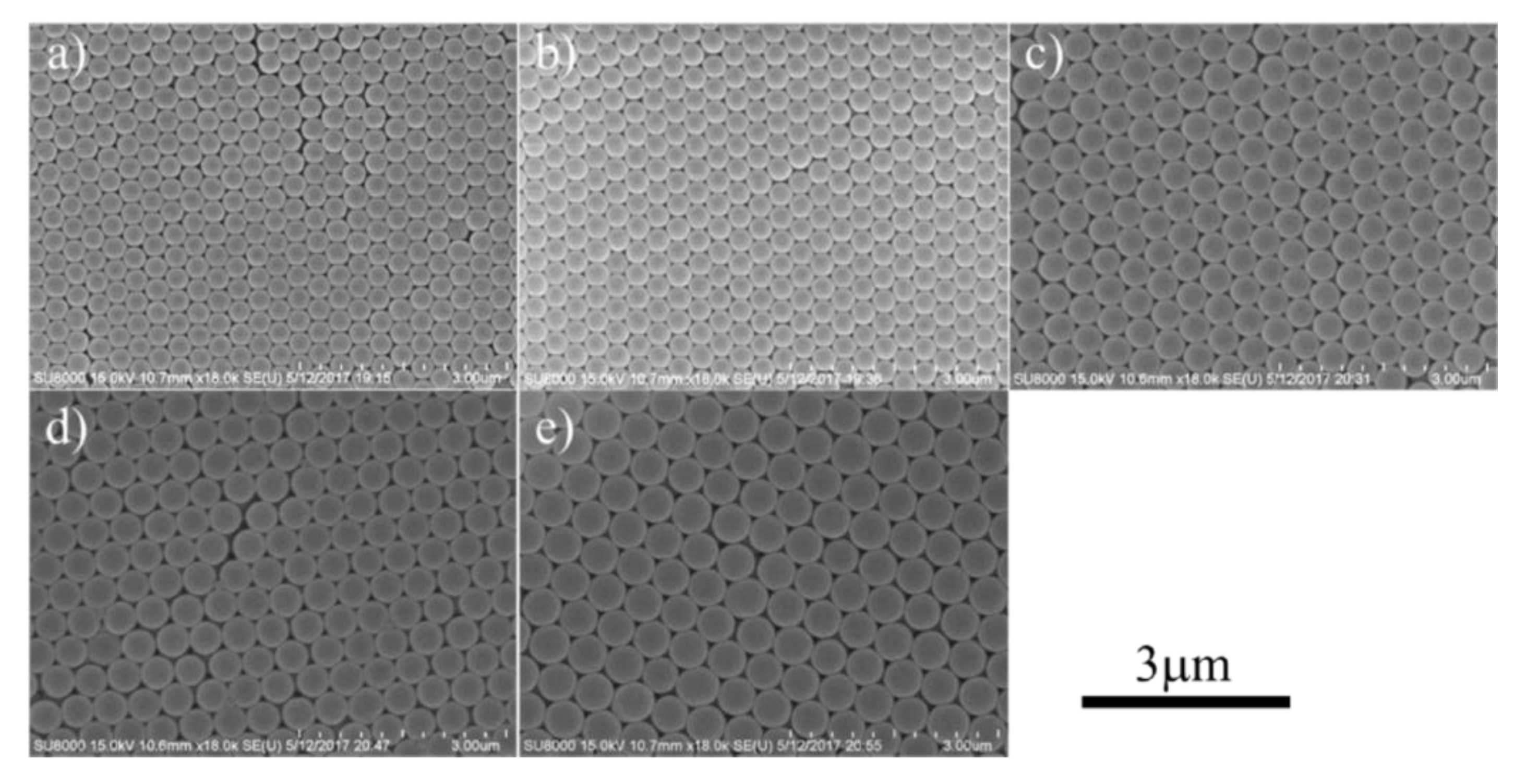
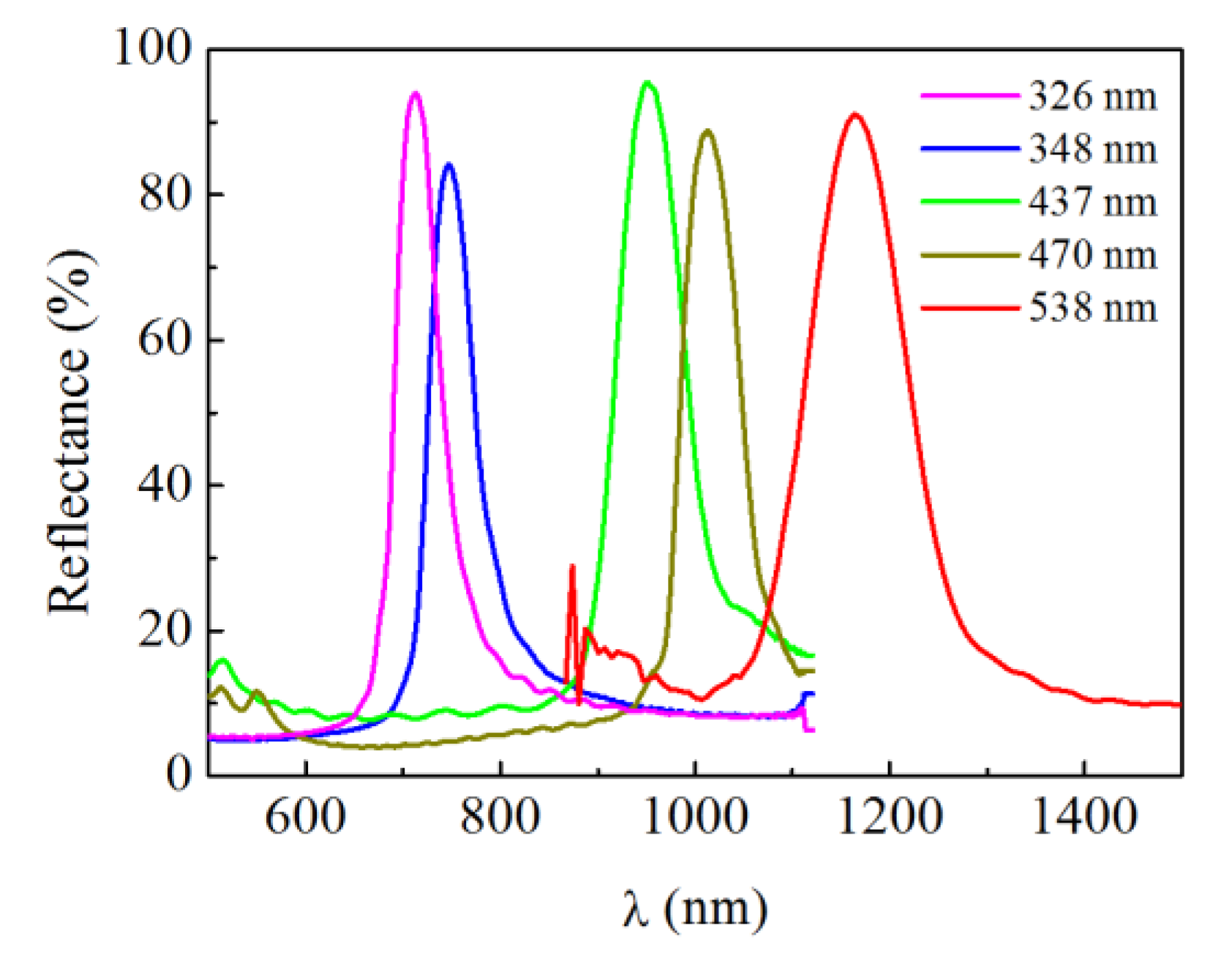
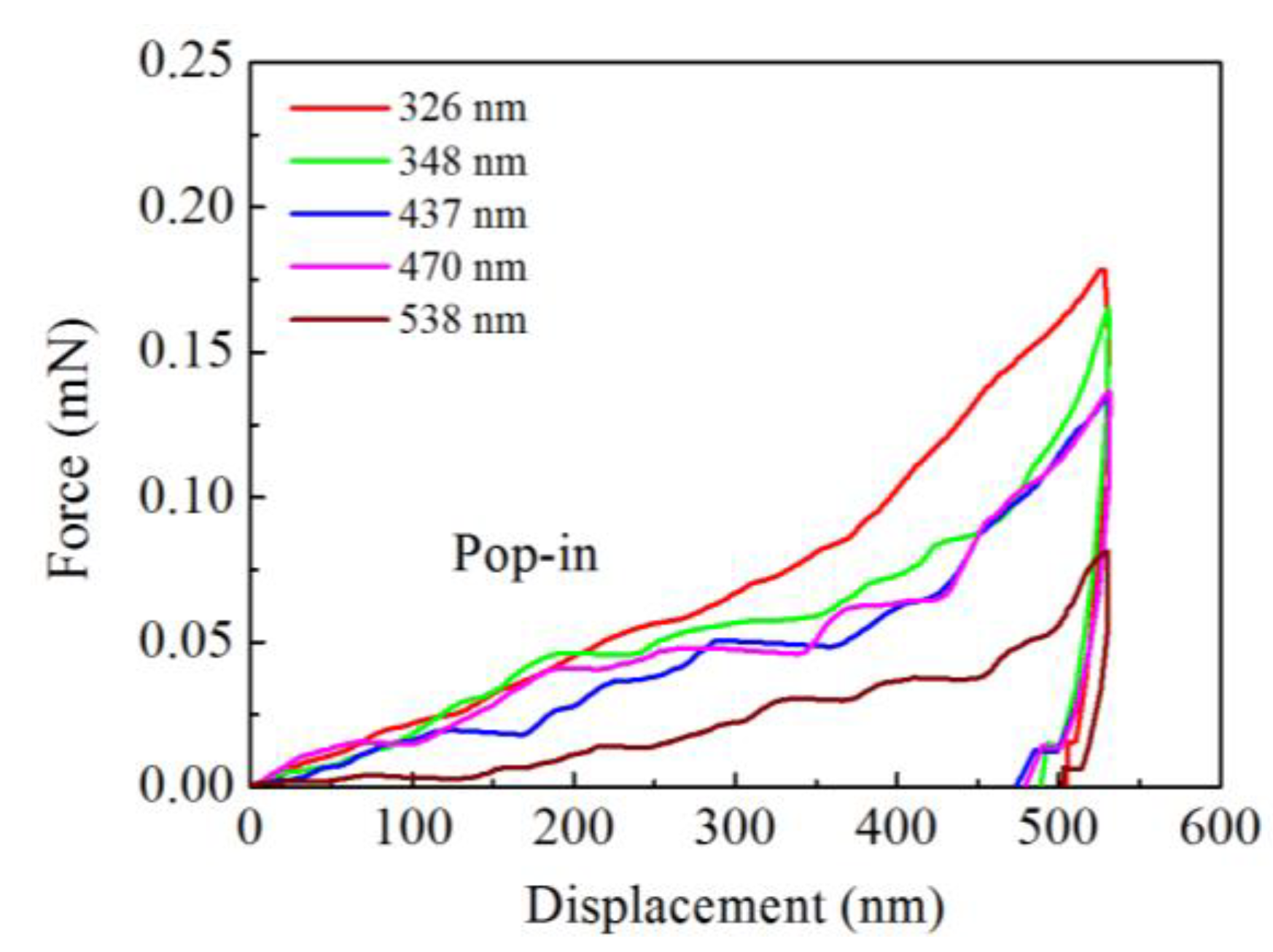
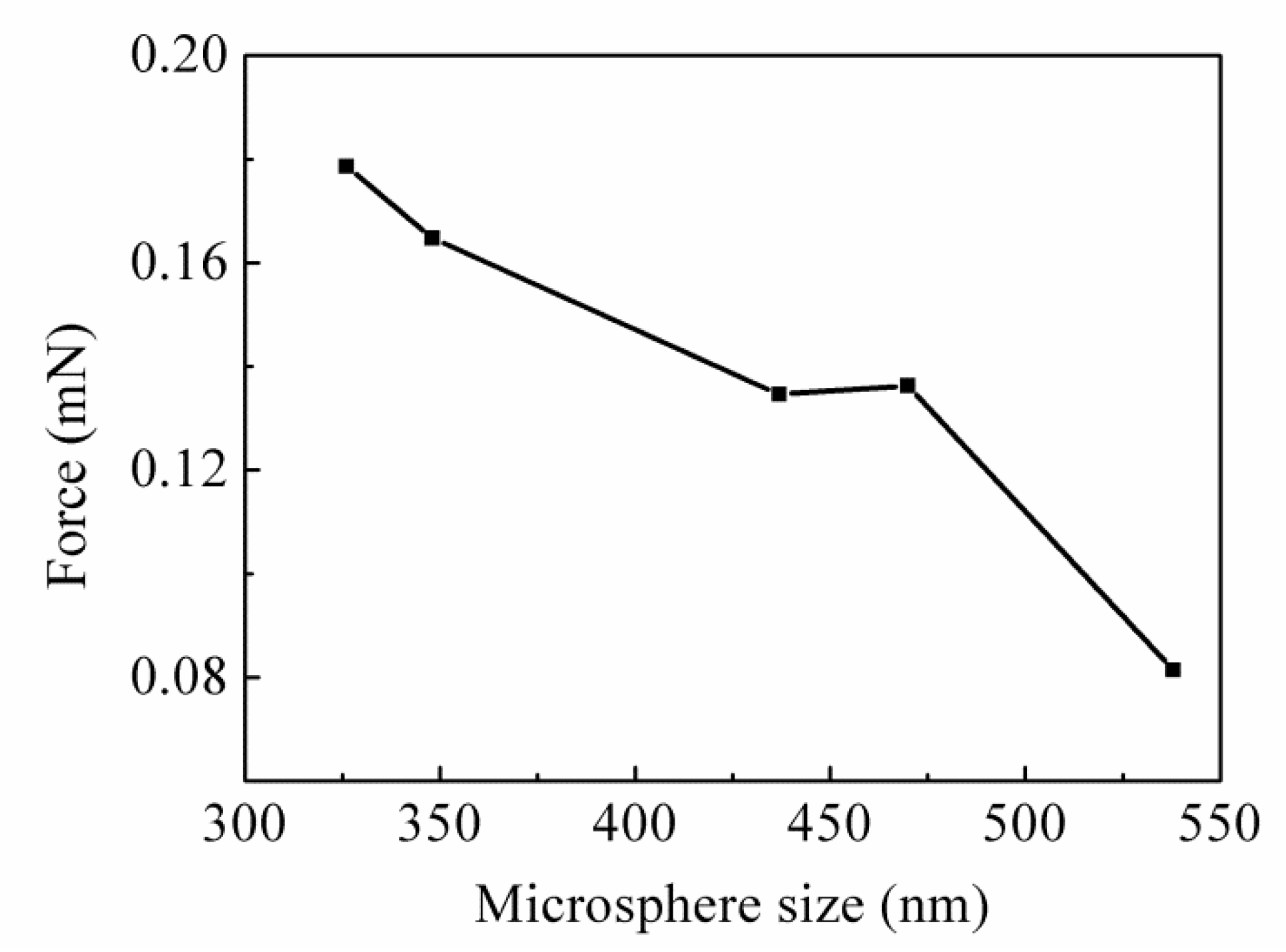
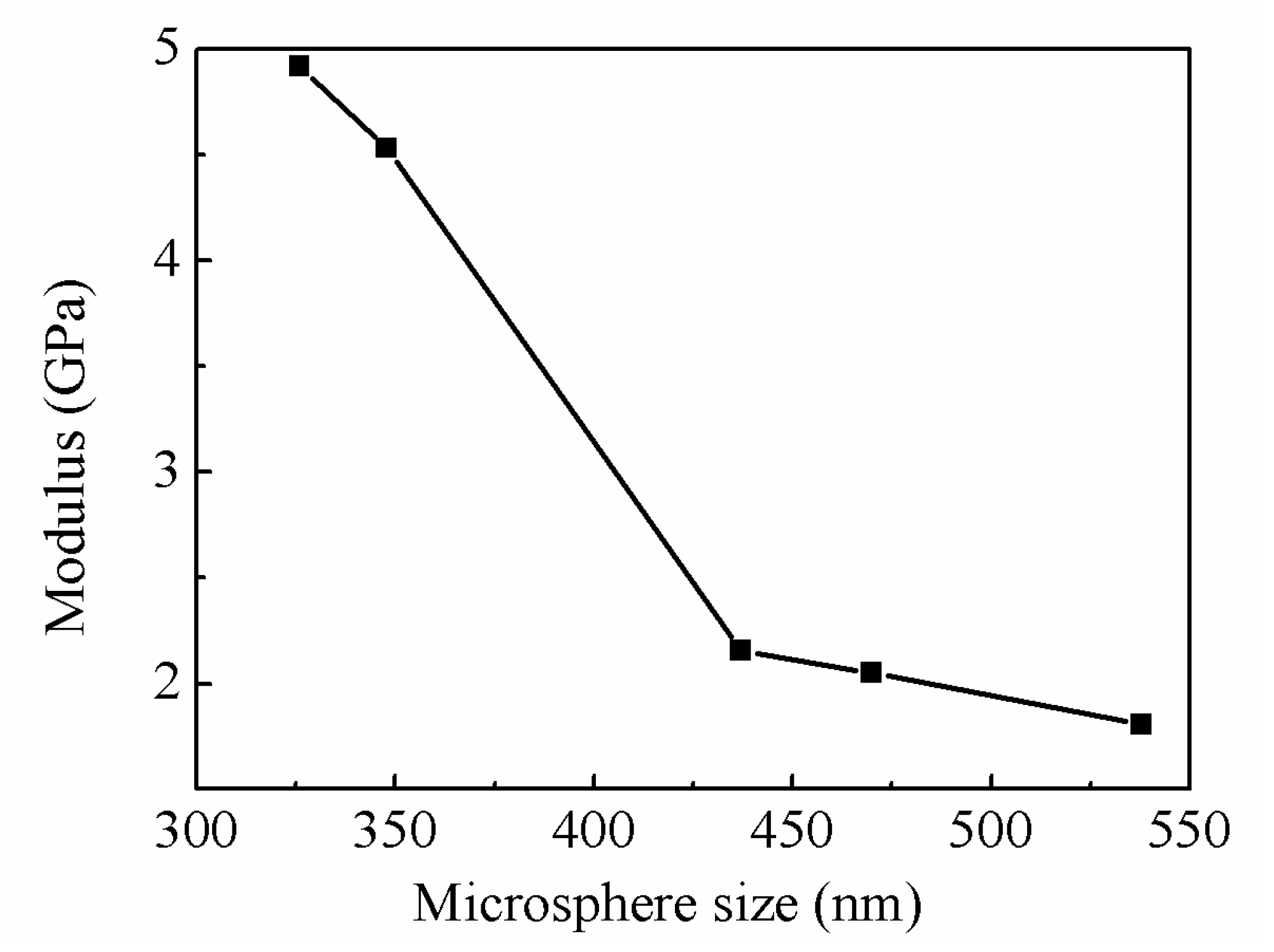
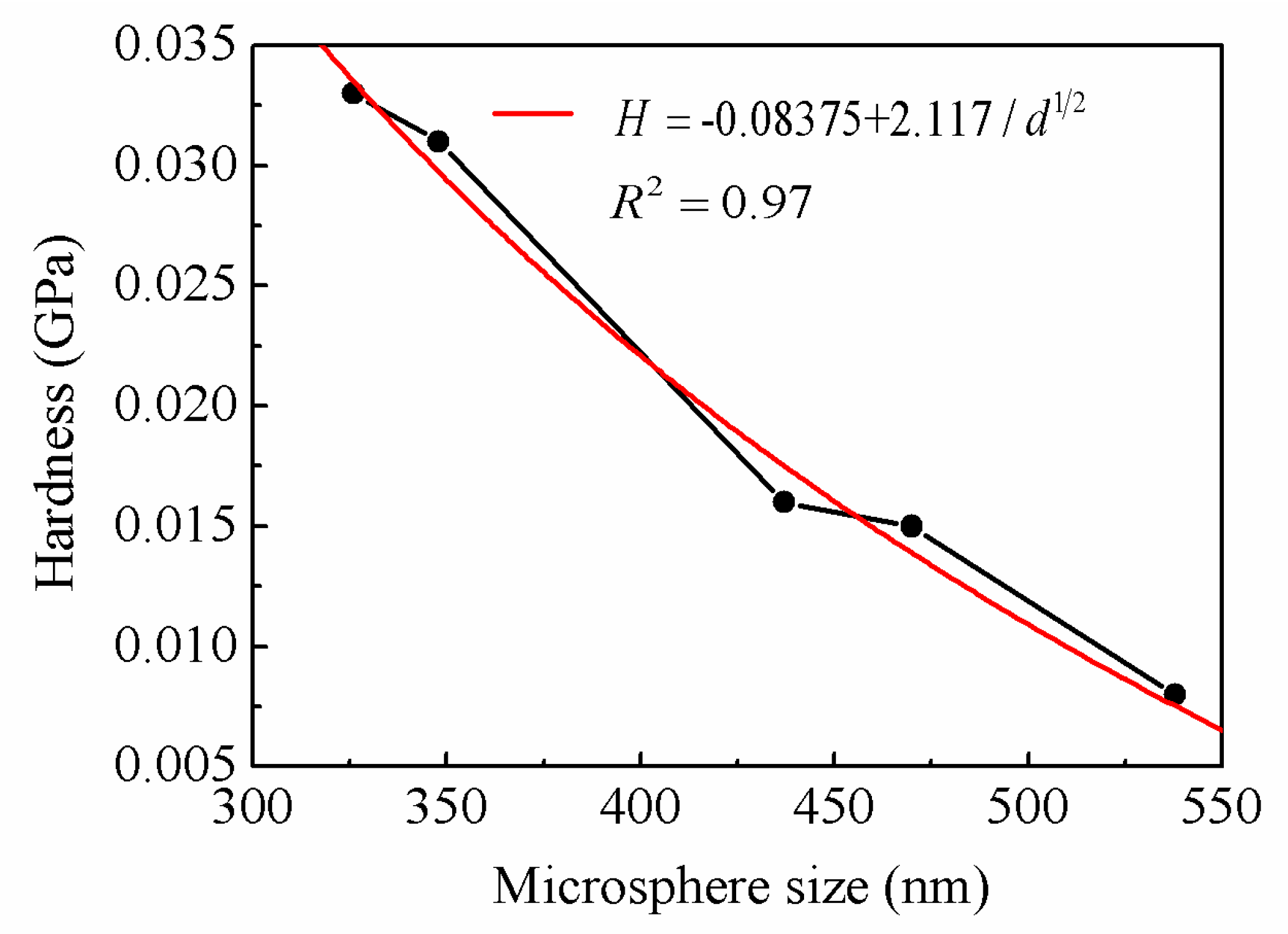
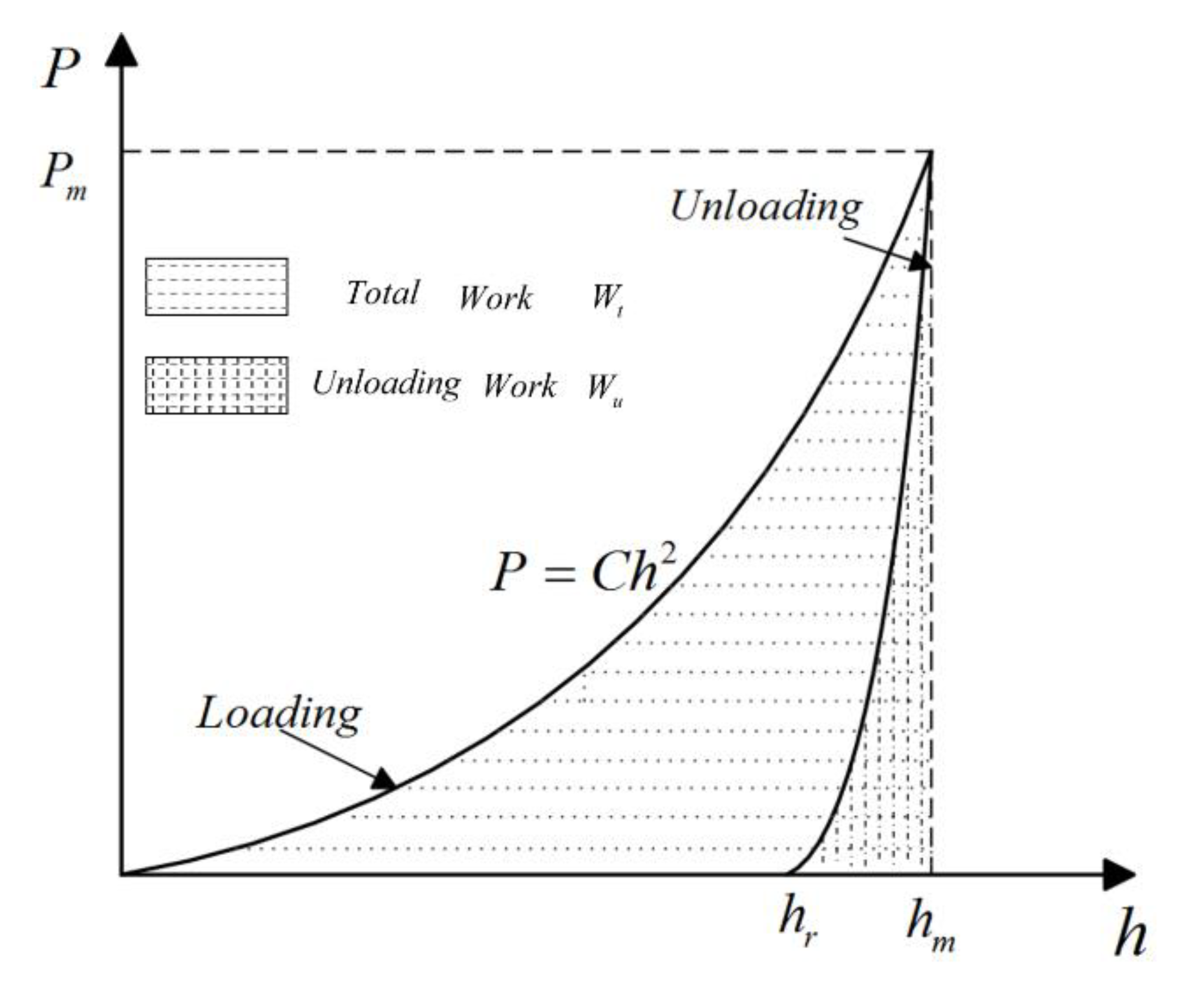
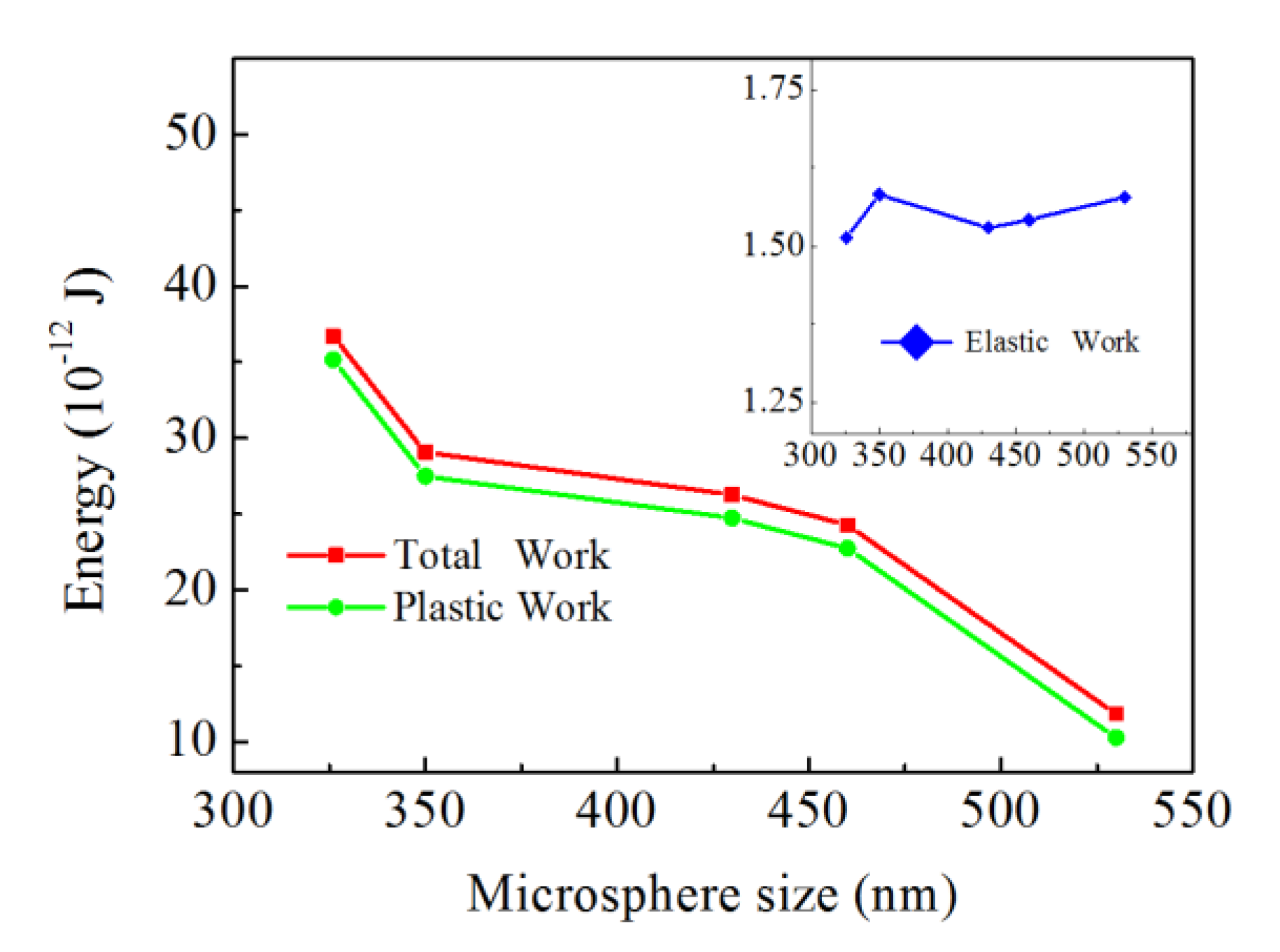
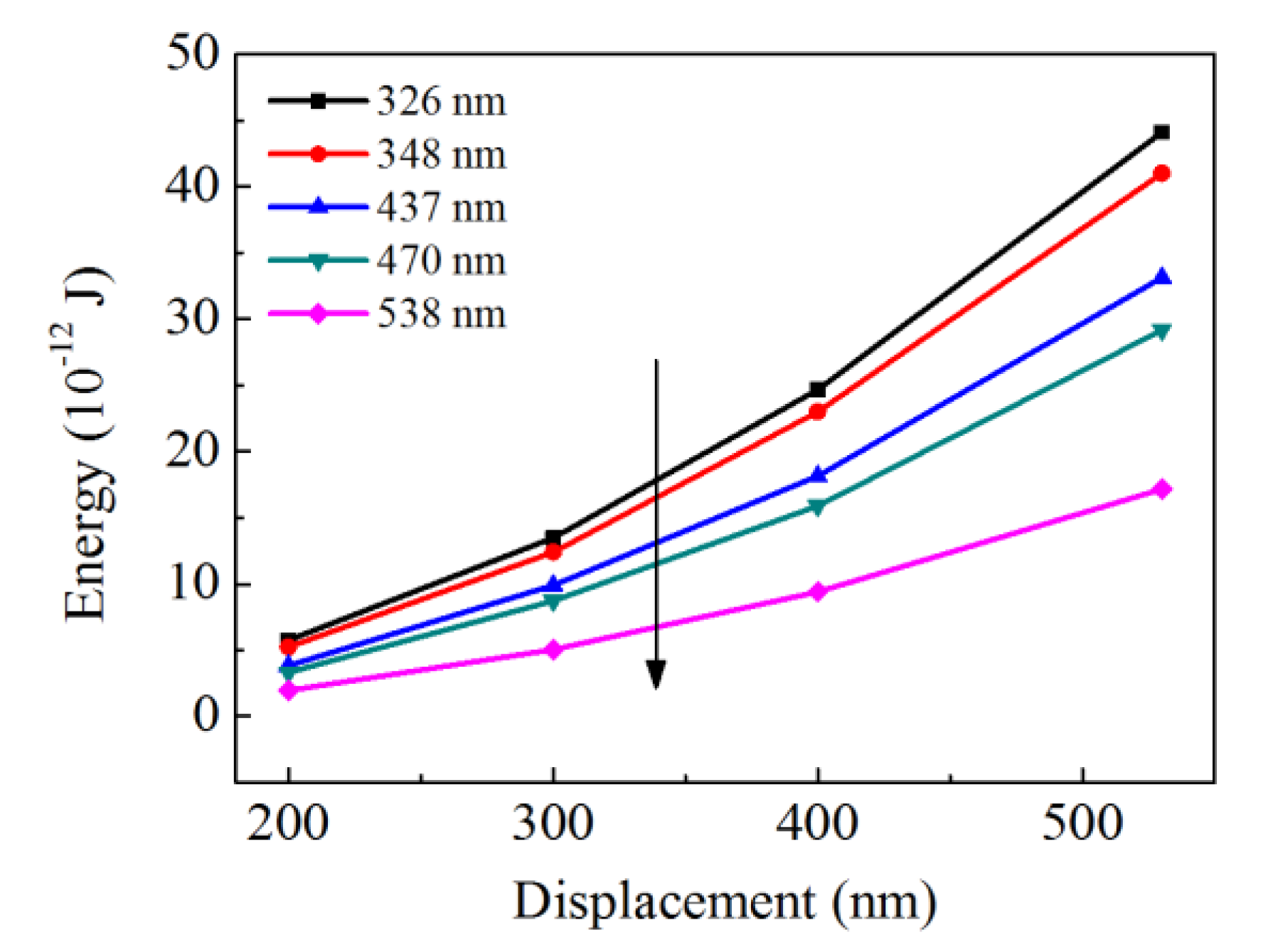
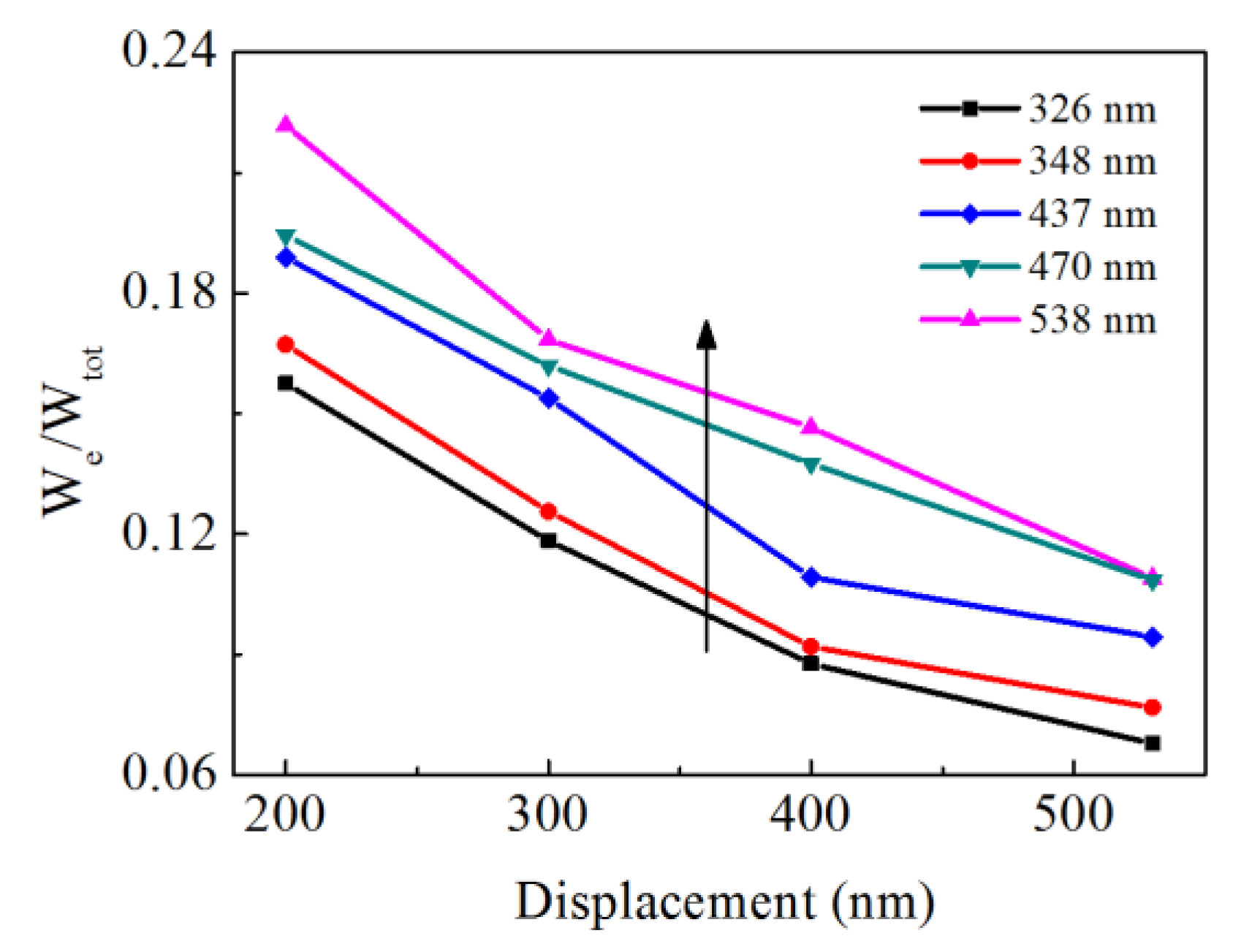
| Sample | Theoretical Value (nm) | Experimental Value (nm) | Error Rate (%) |
|---|---|---|---|
| 1 | 328 | 326 | 0.6 |
| 2 | 349 | 348 | 0.2 |
| 3 | 433 | 437 | 0.8 |
| 4 | 466 | 469 | 0.8 |
| 5 | 536 | 538 | 0.4 |
© 2018 by the authors. Licensee MDPI, Basel, Switzerland. This article is an open access article distributed under the terms and conditions of the Creative Commons Attribution (CC BY) license (http://creativecommons.org/licenses/by/4.0/).
Share and Cite
Wang, Y.; Dou, S.; Shang, L.; Zhang, P.; Yan, X.; Zhang, K.; Zhao, J.; Li, Y. Effects of Microsphere Size on the Mechanical Properties of Photonic Crystals. Crystals 2018, 8, 453. https://doi.org/10.3390/cryst8120453
Wang Y, Dou S, Shang L, Zhang P, Yan X, Zhang K, Zhao J, Li Y. Effects of Microsphere Size on the Mechanical Properties of Photonic Crystals. Crystals. 2018; 8(12):453. https://doi.org/10.3390/cryst8120453
Chicago/Turabian StyleWang, Yuemin, Shuliang Dou, Lei Shang, Panpan Zhang, Xiangqiao Yan, Ke Zhang, Jiupeng Zhao, and Yao Li. 2018. "Effects of Microsphere Size on the Mechanical Properties of Photonic Crystals" Crystals 8, no. 12: 453. https://doi.org/10.3390/cryst8120453
APA StyleWang, Y., Dou, S., Shang, L., Zhang, P., Yan, X., Zhang, K., Zhao, J., & Li, Y. (2018). Effects of Microsphere Size on the Mechanical Properties of Photonic Crystals. Crystals, 8(12), 453. https://doi.org/10.3390/cryst8120453






